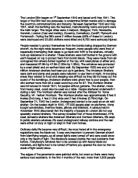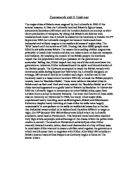The London Blitz began on 7th September 1940 and lasted until May 1941. The target of the Blitz had two purposes; to undermine British morale and to damage the country’s communications and industry. Between September 1940 and May 1941, when the bombing was the heaviest, manufacturing towns and parts were the main target. The target cities were; Liverpool, Glasgow, York, Newcastle, Norwich, London (East end mainly), Coventry, Canterbury, Cardiff, Plymouth and Portsmouth. During the Blitz some 2 million houses (60% of these in London) were destroyed and 32,000 civilians were killed and 8,700 were seriously injured.
People needed to protect themselves from the bombs being dropped by . As the night raids became so frequent, many people who were tired of repeatedly interrupting their sleep to go back and forth to the shelters, virtually took up residence in a shelter. These shelters were half buried in the ground with earth heaped on top to protect them from bomb blasts. They were made from six corrugated iron sheets bolted together at the top, with steel plates at either end, and measured 6ft 6in by 4ft 6in (1.95m by 1.35m). The entrance was protected by a steel shield and an earthen blast wall. By September 1939 one and a half million Anderson shelters had been put up in gardens. The Anderson Shelters were dark and damp and people were reluctant to use them at night. In low-lying areas they tended to flood and sleeping was difficult as they did not keep out the sound of the bombings. Anderson shelters were given free to poor people. Men who earned more than £5 a week could buy one for £7. The was introduced in March 1941, for people without gardens. The shelter, made from heavy steel, could also be used as a table. People sheltered underneath it during a raid. The Morrison shelter was named after the Minister for Home Security, Mr. Herbert Morrison. The Morrison shelter was approximately 6 feet 6 inches (2m) long, 4 feet (1.2m) wide and 2 feet 6 inches (0.75m) high. On September 21, 1940 the London Underground started to be used as an air raid shelter. On the busiest night in 1940, 177,000 people slept on platforms. Many bought sandwiches, thermos flasks, pillows and blankets. A census held in November 1940 discovered that the majority of people in London did not use specially created shelters. The survey revealed that of those interviewed, 27% used domestic shelters like Anderson Shelters and Morrison Shelters, 9% slept in public shelters whereas 4% used underground railway stations and the rest were either on duty at night or slept in their own homes.







